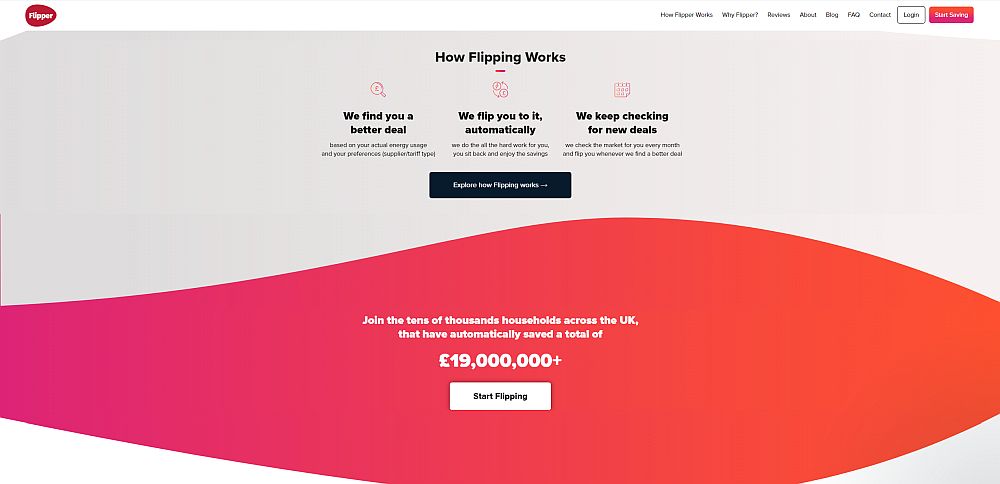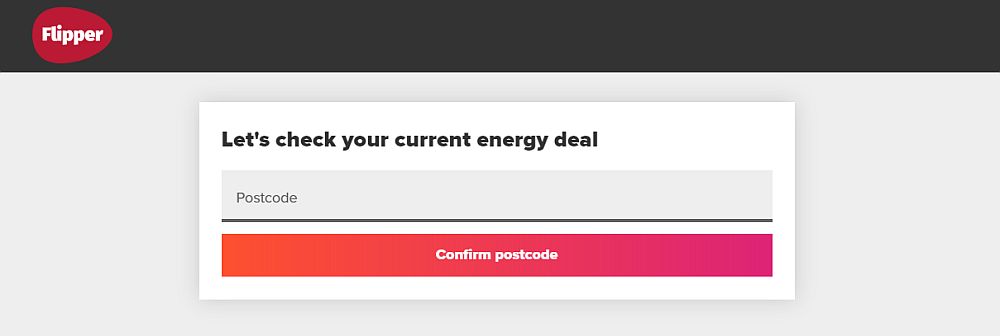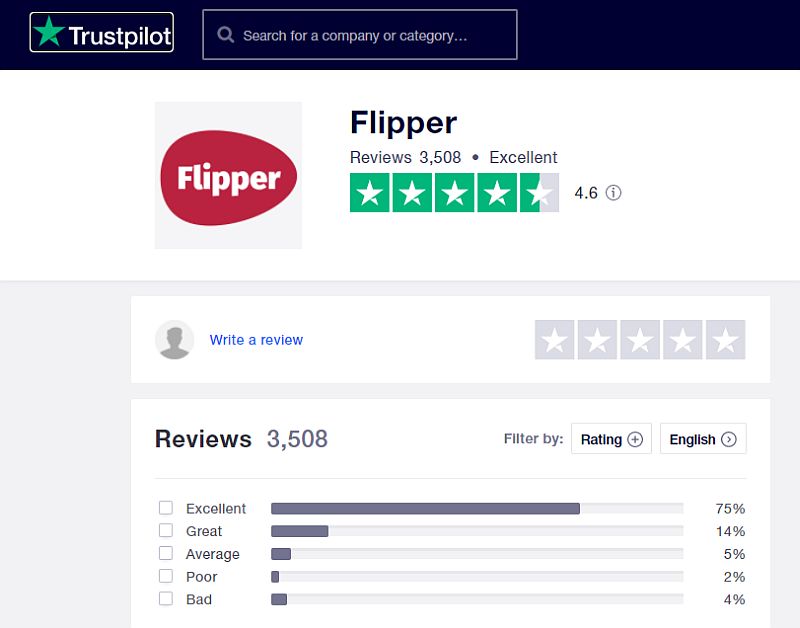Flipper Review – Find Better Energy Tariffs Automatically
Not too long ago, the UK had 6 energy suppliers. Now, the number has ballooned to 60. Our deregulated energy market gives us ‘energy choice,’ where we can pick and choose our energy providers when better tariffs come along.
Not many countries have this luxury.
In contrast, the US energy market is highly regulated despite boasting over 3,000 suppliers. Apart from a few lucky states with ‘energy choice,’ most jurisdictions don’t give you the leisure of switching. You’re just stuck with your regional provider until the bitter end.

In this post, we’ll see how Flipper, an auto-switching service, helps you exercise your energy freedom and keep your bills as low as possible.
What is Flipper?
Flipper is an automated service that’s helped the UK switch energy providers since 2016 – the first such company in the nation.
Upon subscription, Flipper uses your gas and electric bills to assess your energy use, and find you a fitting tariff before performing the switch for you. Their service takes cancellation, paperwork, etc., out of your hands.
Once you’re registered, Flipper automatically scans the energy market for a better rate every month and performs subsequent swaps on your behalf. All you have to do is approve a proposed provider swap once Flipper notifies you that there’s a better deal. You only pay the service fee when Flipper has changed your provider and saved you £50 per year.
How much can Flipper save?
The minimum you’ll be saving before any switch takes place is £50 annually. On average, Flipper boasts annual savings of £385. On the higher end of the scale, you may save up to £587 by using Flipper instead of a price comparison website.
Is Flipper a Price Comparison Site?
No. Flipper is an auto-switching service. And while the two share similarities, some key distinctions set them apart.
Firstly, price comparison websites only let you browse energy tariffs. They suggest rates that would offer you the best possible savings based on the data you’ve supplied, and you have to perform the swap yourself. The process is often simple, where all you’ve got to do is fill out and submit a form. But after that, you’re on your own again, browsing for better tariffs and initiating swaps.
Auto-switchers, on the other hand, take care of everything for you. They scan the energy market and execute the change on your behalf. Some, like Flipper, do it regularly, so you never miss a better tariff.
Secondly, price comparison websites work on commission. When you pick a tariff through their site, they get their piece of the pie. With this framework, these websites can only access those providers who agree to pay a commission – far from the 60 that serve the UK. Apart from missing providers, comparison sites may also favour those that pay them to promote their tariffs.
What about auto-switchers?
In contrast, auto-switching sites make their living by collecting a service fee from the customer. This commission-free business model lets them t reap a profit while gaining access to more energy providers.
Some auto-switchers, like Switchd, employ a hybrid system. Their free plan includes tariffs from energy companies who pay the commission fee, thus offering lower savings to the customer. Their paid plans boast better savings, as they cover all available tariffs.
Finally, most auto-switchers offer in-house customer support, either over chat, email, phone, and WhatsApp, depending on the company. Flipper, for instance, will address your queries over email (5-day response time), phone (Monday to Friday, business hours), and live chat. Price comparison websites, on the other hand, leave you to deal with your provider once they’ve made the switch.
How Does Flipper Work?
You must sign up to Flipper’s subscription to take advantage of their switching service.

Here’s what you can expect from registration.
You start by entering your postcode. Then, you tell Flipper if you have electricity, gas, or both supplied at your property, and whether the supplier is the same.
At this stage, Flipper lets you point out your suppliers, and input your energy usage in pounds, monthly or yearly. If you’re not sure how much you use, Flipper will estimate it for you based on the size of the household. Keep in mind that this is only an estimate – Flipper’s intelligent algorithm will calculate your savings with more precision after you give them access to your energy account; we’ll explain how this works in the next section.
Next, you’ll see Flipper’s rough estimate of your savings. This is your chance to tell the service what sort of tariffs you want. You may request the best tariff from all available providers, or stick with the ‘big six’. Likewise, you may include fossil-fuel-generated electricity for more savings, or choose green-only providers.
After you’ve specified your tariff preferences, you complete the registration, and your Flipper account goes live.
Now, Flipper gets to the real number-crunching. Their algorithm pulls data from your energy account, or PDF bills, to establish your energy usage.
Then, Flipper does what they do best – search the market for better tariffs, based on your usage and preferences (read the next section to see how their calculations work). Once they find a good enough provider and a tariff that meets the £50 savings guarantee, Flipper will alert you to the switch.
At this point, you can expect an email detailing your new tariff, and the new supplier’s welcome pack. They also set up an online account with the new supplier and store your login details on your Flipper profile.
Next, your new supplier requests your meter readings, and Flipper submits them on your behalf. The new supplier engages the old one to make sure you’re not double-charged. Finally, Flipper tells you when the new provider is supplying your energy. And you’re done!
Now, all that’s left is to settle your last bill from the provider you just dropped, and enjoy savings until Flipper finds you something better. Oh, and yeah – now’s the time to pay Flipper’s annual service fee of £30.
How Does Flipper Calculate Your Savings?
As we mentioned before, Flipper guarantees a minimum savings of £50 for every swap they execute on your behalf, with potential economies of up to £587. Do you wonder how they arrive at these numbers? Let’s take a look.

First, their intelligent algorithm (named Joules), weighs your current tariff, exit fees and your energy use patterns. Then, Joules scans through available tariffs and counts whether you’ll save more by switching right away or waiting a bit. In this forecast, Joules factors in the switching time, as the sooner you’re on a cheaper tariff, the more economy you’re bound to see.
Can I Review the Deal Before Switching?
Yes, and no. Flipper does not wait for you to confirm or reject the deal. When a great tariff becomes available, they initiate the switch right away. They seal the deal quickly because some tariffs don’t last long, and your opportunity for savings may sail away while you think about it.
That said, you don’t have to stay with the deal they’ve found. Flipper emails you the details of the tariff, and from that time, you’ve got 14 days to rescind. This time is known as the cooling-off period. Contact Flipper, and they will aid with cancellation. Then you may keep the current provider until Flipper finds a replacement that you fancy.
What Meters and Tariffs Does Flipper Support?
At the moment, Flipper supports these meter types, as long as they are paid monthly by direct debit:
- Standard single rate – profile class 01, aka ‘general domestic’ or ‘GD.’
- Economy 7 – profile class 02, where the day and night rates differ
If you have a smart meter, the new supplier may not be able to read from it. That’s why the folks at Flipper will help you handle the transition; just let them know you have a smart meter.
Sadly, Flipper’s platform is not compatible with prepayment meters. So if you pay for your electricity ahead of time, you will not be able to use this service. Likewise, Flipper does not support the meters/tariffs listed below:
- Warm Home Discounts
- Economy 10 meters
- Economy 20:20 meters (20% off discount on weekend and evening usage)
- Related MPANs
- 3-rate tariffs
- Non-domestic tariffs
- Unmetered supply
- Green deal
- Feed-in tariff
How Does Flipper Select Suppliers?
As we’ve mentioned before, you get to pick whether you want all providers, the ‘big 6’, and green-only tariffs. But these aren’t the only parameters Flipper uses to screen tariffs for you. They’ve got a few requisites of their own for choosing suppliers, all of which mirror Ofgem’s:
- Suppliers take 35 days or less to perform the switch upon receipt of your application, with no home visits required to complete the switch.
- Suppliers must furnish full particulars of the new tariff, and offer a 14-day cooling-off period, during which you can rescind the switch.
- The new supplier, and the one you’re ditching, collaborate to make sure that you’re not double-charged for the same usage and alert us to any issues with the swap without delay.
- Suppliers send you accurate bills regularly – at least once every 6 months. The bills should be made available on your online energy account.
- Suppliers send your last bill within 6 weeks of the flip and issue any refund owed no more than 14 days later.
- Suppliers must allow direct debit payments.
Flipper also nixes suppliers from their tariff database should the latter perform poorly, or earn negative feedback. And, as a customer, you can tell Flipper which suppliers to exclude from your tariff search.
How Long Does it take to Switch?
According to Flipper, most swaps take between 17-35 days.
As we’ve said above, suppliers have only 35 days to execute a switch – that’s an Ofgem requirement. Hence, it’s the longest time you should expect to wait.
Conversely, it can take half as long if the supplier cancels promptly, and the new supplier gets you online without delay after your 14-day cooling-off period.
Flipper warns that on occasion things may drag a bit more. And that’s nothing to fret about. Ultimately, the old supplier will issue your last bill and refund within 6 to 8 weeks of the switch.
How Much Does Flipper Charge?
Unlike their peers over at Switchd, the guys at Flipper only have one pricing plan. £30 per year, due after the first switch.
Remember, they’ll only change your supplier if the other tariff saves you £50 or more. Your membership will be up for renewal one year after the first payment, at which point you’ll have the option of cancelling or auto-renewing.
What do Customers Think About Flipper?
After 4 years in business, Flipper has racked up close to 3,500 Trustpilot reviews.

Based on these, the service gets a rating of 4.6 – Excellent. Most positive reviews sang praises to Flipper’s simple switching. Many of the happy customers also noted responsive customer service and regular updates on upcoming switches and cancellation.
While a good chunk of the reviews came from recent subscribers, a few have been with Flipper long enough to disclose their savings. Per the reports, these ranged from £260-£700.
The most pressing issues revealed by Trustpilot reviewers had more to do with their old suppliers. Reading these reviews, one can feel that if the existing supplier does not cooperate, there’s little Flipper can do to help. You’re on your own to settle the last bill and resolve disputes.
Of course, there are a few ‘poor’ and ‘bad’ reviews as well, about 6% to be exact. These users mostly griped about a tangled switching process, notably their dealings with the old supplier. Some reported overhyped savings that never came true. A few truly vexed Flipper users noted poor communication from the service team and inept customer support.
Interestingly, some comments point to faulty estimates that stemmed from abnormal usage sent to Flipper during sign up. If you recall, Joules needs your recent energy bills to figure out your use patterns before searching for the right tariff. So, it seems that Flipper’s Joules needs stable usage data to make informed decisions.

As we’re about to conclude the post, let’s go over some pros and cons of Flipper’s service.
What are the Pros of using Flipper?
- Flipper’s fee is relatively small, at £30 per year, and only charged after savings of £50 or more are found.
- Flipper doesn’t charge commission fees to the energy companies, thus offering a vast, unbiased collection of tariffs to select.
- Flipper’s algorithm factors in your usage before finding a tariff that fits you well.
- You may choose which suppliers are included in the tariff search and have the option of picking green-only companies.
- Flipper’s switching process is simple. As a customer, you only have to submit your meter readings when you’re asked. Plenty of reviews attest that this is the case.
- After switching, Flipper’s algorithm scans the energy market for more favourable tariffs every month.
- Flipper informs you of upcoming swaps, with full tariff and energy provider details. You have 14 days to cancel before the swap.
- Based on Trustpilot reviews, if your trust them, Flipper has saved its customers £260-£700 annually.
- Flipper offers customer support over live chat, email, and over the phone.
What are the Cons of using Flipper?
- During the switch, you may be left to sort out your outstanding fees, refund, and last bills with your existing provider. As several Trustpilot reviews point out, there are times when Flipper can’t do much to help you with this or expedite the process.
- Customers report mix-ups between old and new suppliers, which at times cause double charges.
- Anomalies in the bills you give Flipper during sign up may lead Joules astray. Consequently, he might stick you with a tariff you don’t want.
What are the Alternatives to Flipper?
Flipper is not the only auto-switcher on the market. Their closest competitors are Switchd and Look After My Bills, both of which are automatic switchers, not price comparison sites.
Switchd works similarly to Flipper but has a range of service plans, so you can have a free subscription, or pay £4.99 p.m. for premium service. With the free service, Switchd charges a commission to their energy supplier and has fewer tariffs to offer you. With all paid services, Switchd scans the full range of tariffs and providers but has varying levels of customer support. They’re rated well on Trustpilot, but being a newer service, have fewer reviews than Flipper.
Look After My Bills is a free auto-switching service. You probably know what this means by now, but we’ll reiterate: they collect commission fees from the energy providers to whose tariffs they switch you. If you’re OK with the likely conflict of interest and leaving out providers who refuse to pay commission, then Look After My Bills may work for you.
Then there are the countless price comparison websites. While they handily display the best available deals you can switch to, the switching process is manual, and will not happen again unless you initiate it yourself. These sites also live off commission fees.
Final thoughts
As a nation flooded with suppliers, the UK is lucky to have ‘energy choice’. To enjoy this freedom, one must switch regularly, and auto-switching sites like Flipper offer a handy alternative to scouring the net and changing manually.
For a £30 fee, Flipper vows to keep switching you as long as better tariffs come up.
If you believe Trustpilot, most Flipper users are quite content with the service and its value.
On the downside, any outstanding disputes with your existing provider are your own – Flipper can only try to help.
Did we miss anything?
Have you got anything to add? Do you have experience with Flipper or a similar service?
If you’ve answered yes to either of these questions, kindly leave our readers and us a comment below!
